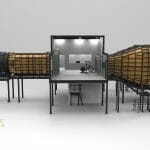Factory which manufactured more than 10,000 Spitfires during WWII and now produces Jaguars receives recognition
20 November 2018
Jaguar Land Rover’s Castle Bromwich Assembly Plant has been presented with a prestigious Engineering Heritage Award by the Institution of Mechanical Engineers which recognises its engineering importance as a plant that has been at the forefront of innovation, technology and high-quality manufacturing for nearly 80 years. The ceremony was held on Friday 16 November 2018.
The Castle Bromwich Assembly Plant was a major contributor to the war effort through the manufacture of two of Britain’s most iconic aeroplanes. An estimated 11,989 Spitfires and around 305 Lancaster Bombers were produced at the site.
Spitfire P7350, currently the oldest airworthy Spitfire in the world, was built at Castle Bromwich. The plane, which fought in the Battle of Britain, is one of a number of Spitfires produced at Castle Bromwich which fly with the Battle of Britain Memorial Flight, an event which was also awarded a coveted Engineering Heritage Award.
The assembly plant is now home of the iconic brand Jaguar Land Rover, where a number of Jaguar models have been produced which have featured in James Bond films.
This was the 124th Engineering Heritage Award to be presented by the Institution of Mechanical Engineers.
The awards, established in 1984, aim to promote artefacts, sites or landmarks of significant engineering importance – past and present.
Previous winners of Engineering Heritage Awards include Alan Turing’s Bombe at Bletchley Park, the E-Type Jaguar and Concorde. The Jaguar E-type, a direct descendant of the cars which won five Le Mans 24-hour races during the 1950s, introduced breakthrough motor engineering technology such as the combined monocoque-spaceframe, which in later years was adopted by Formula One.
John Wood, Chair of the Engineering Heritage Committee and Past President, said:
“For almost eight decades, the Castle Bromwich Assembly Plant has provided jobs for the local community, trained and developed engineers and has produced some of Britain’s most iconic aircraft and automobiles. This award also serves as an opportunity to recognise the contribution made by the women of Castle Bromwich and the surrounding areas who made up an estimated 40% of the workforce producing these aircraft during the war.”
For an image of the presentation, please click on the link at the top of the email which shows John Wood, Chair of the Engineering Heritage Committee and Past President of the Institution, a representative from JLR, and Drew Taggart, Regional Chair.







